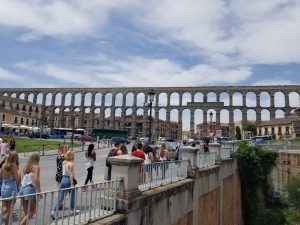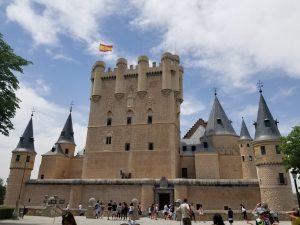During my 6-week study abroad program in Spain, my professor took my colleagues and I to visit the breath-taking city of Segovia. Merely being able to see Segovia from afar on our bus, the city appeared rich with history that dated back centuries ago. It welcomed you and captivated your attention with both its unique architecture and luscious scenery. Upon entering the city, the two structures that immediately caught my attention were the Aqueduct of Segovia and Alcázar de Segovia (castle). The Aqueduct was originally proposed and built by the Romans under the reigns of Emperor Domitian, Nerva, and Trajan between approximately 81 – 112 AD. Being one of the most well-preserved Roman engineered structures, it is still currently used in Spain today. The aqueduct carries water 10 miles from the Frío River to the city of Segovia. The aqueduct fits in beautifully with the rest of the Roman structures and seems to serve as a welcome to anyone who walks beneath its granite arches to further explore this historic district of Segovia. Upon further exploration beyond the aqueduct and other magnificent structures, the Alcázar de Segovia stands tall above all the others and its history well depicted both within and outside its walls. The Alcázar was originally built as a fortress but was used as palace, military school, prison, and Royal Academy College (all under separate time periods respectively). Amazingly, despite the castle being centuries old and passed on between kings, Alcázar still contains original structures from which it was first constructed and the history engraved well intact. Each room within the castle felt unique, each with its own story to tell. From the minute detail of the ceilings to the engravings and paintings of the church, the castle serves as beautifully preserved historic structure that depicts an important part of Segovia’s legacy. The Alcázar is currently used as a museum which provides tours to anyone willing to learn more about specifically Segovia’s roots and was by far the high point of my trip to Segovia.


